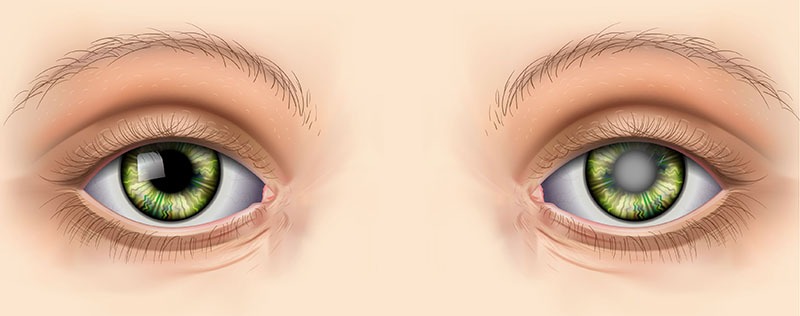
Cataract is a very common eye disease. In 2012, World Health Organisation has published a report which pointed out that cataract was the first cause of blindness in the world.1 In 2009, the Hong Kong Hospital Authority has found that more than 54000 people was waiting for cataract surgery in public hospitals, of which over 42000 were of age 71 or older. Those statistics has shown that cataract is a prevalent eye disease. The symptoms, causes, prevention and treatment of cataract will be discussed as follows:
Symptoms of Cataract:
There is a transparent crystalline lens in every normal human eye, its function is to focus light from the seeing objects onto the retina. However, the crystalline lens of cataract patients becomes cloudy, which causes various symptoms:
- Blurred vision
- Double vision in the affected eye
- Photosensitive, especially under sunlight
- Fading colour or yellowing of colour of the seeing objects
- Amount of myopia (shortsightedness) keeps increasing, or unstable prescription
Causes of Cataract:
The transparent characteristic of the crystalline lens is attributed by the regularly arranged lens fibres inside the crystalline lens. With advancing age or exposing to some risk factors, the arrangement of the nicely packed lens fibres is disrupted, which causes the cloudiness. Various risk factors are listed as follows:
Aging leading to lens degeneration, the most common cause
Long term exposure of ultraviolet (UV) light from the sun to the eyes
Previous ocular trauma
Previous intraocular surgery
Having systemic disease, such as diabetes mellitus
Long term systemic or topical use of steroid
Family history of hereditary cataract
Prevention of Cataract:
Within this 10 years, different research has tried to find out if there are any vitamins or nutritional supplements that are able to prevent cataract. Nonetheless, there is no strong evidence showing vitamins or nutritional supplements can provide preventive effect.2-4
Another direct way to prevent cataract is to reduce the amount of UV sunlight exposing to the eye. When doing outdoor activities, wearing sunglasses with 100% UV blocking ability is necessary, using umbrella and wearing hat can also reduce the amount of UV exposure.
Treatment of Cataract:
Cataract surgery is currently the most effective way to treat cataract. Phacoemulsification is a modern cataract surgery being performed commonly. It is a minimally invasive surgery, and is usually performed under local anaesthesia. Patients do not need to be hospitalised.
Ophthalmologists will use the ultrasound energy to break the cloudy lens into fragments and then aspirate them from the eye with a suction. Intraocular artificial lens which is with appropriate amount of prescription being measured preoperatively will be implanted into the eye.
Cataract will not recur after surgery. However, for some patients, vision will be affected by a condition known as posterior capsule opacification after finishing the cataract surgery for a certain period of time. Posterior capsule opacification can be easily managed by laser treatment which opens a hole on the opacified capsule.
By Paco Chan, Registered (Part I) Optometrist
Eyecare information by Swisscoat Vision Centre
Address : G/F Yuen Yick Building, 27-29 Wellington Street, Central, Hong Kong
Appointment :+852 3579 4763
Website : www.swisscoat.com
References:
- Pascolini D, Mariotti SP. Global estimates of visual impairment: 2010. The British journal of ophthalmology 2012; 96(5): 614-8.
- Chew EY. Nutrition effects on ocular diseases in the aging eye. Investigative ophthalmology & visual science 2013; 54(14): Orsf42-7.
- Clinical Trial of Nutritional S, Age-Related Cataract Study G, Maraini G, et al. A randomized, double-masked, placebo-controlled clinical trial of multivitamin supplementation for age-related lens opacities. Clinical trial of nutritional supplements and age-related cataract report no. 3. Ophthalmology 2008; 115(4): 599-607 e1.
- Age-Related Eye Disease Study Research G. A randomized, placebo-controlled, clinical trial of high-dose supplementation with vitamins C and E and beta carotene for age-related cataract and vision loss: AREDS report no. 9. Archives of ophthalmology 2001; 119(10): 1439-52.
